Your cart is empty!
- Edition of 10
- 30 x 36.7 in / 76.2 x 93.2 cm
- Giclée print on Hahnemühle Photo Rag 308 gsm
- Signed & numbered on front
- Certificate of authenticity
- Free shipping worldwide
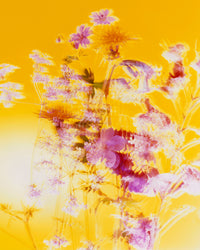
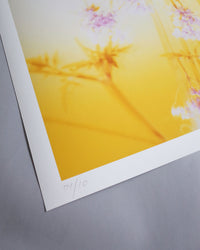
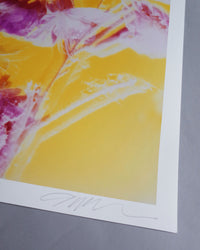
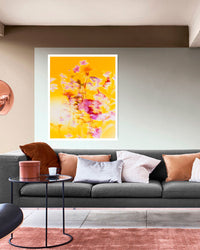
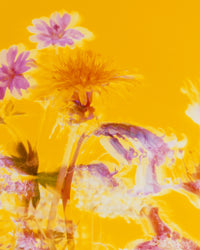
£600.00
_____
Gareth McConnell’s Dream Meadow XXXVI, 2022 is a luminous, dreamlike vision, a photographic meditation that blooms with intensity and layers of meaning. To view this work in isolation is to miss the undercurrents that make it more than a celebration of floral beauty. The glowing, otherworldly palette and soft-focus depths of Dream Meadow emerge from McConnell’s broader photographic practice, which is as much about personal and political history as it is about aesthetics.
McConnell’s early series Anti-Social Behaviour Parts I & II (1995) confronted the brutal realities of Northern Ireland’s conflict, depicting victims of paramilitary violence and intravenous drug users from his own community. These were raw, confrontational images, filled with pain, but also an intimacy that spoke to McConnell’s personal proximity to the subjects. Later works, such as Meditations (2004–08) and Night Flowers (2002–10), marked a shift—one that might seem escapist at first glance. But McConnell’s floral studies are not simple celebrations of nature’s beauty; they are haunted by the histories that precede them. The dreamlike saturation and glow in Dream Meadow evoke the altered states of consciousness induced by drugs or trauma, recalling both personal memory and broader cultural anxieties.
In art history, McConnell’s work aligns with a long tradition of floral imagery used to explore transience, beauty, and mortality—echoing the vanitas still lifes of the Dutch Golden Age, where lush bouquets coexisted with symbols of decay and impermanence. His work also shares affinities with artists like Robert Mapplethorpe, whose florals were both erotically charged and melancholic, or Nobuyoshi Araki, who intertwined botanical studies with themes of life and loss. Yet, McConnell’s lens is uniquely contemporary, informed by the visual language of advertising and psychedelia, suggesting beauty as both seductive and suspect.
The tension in Dream Meadow XXXVI —between attraction and unease, between the artificial and the organic—asks us to question the nature of beauty itself. Can beauty exist in a vacuum, free from history? Or is it always shadowed by the suffering and struggle that precede it? In McConnell’s work, beauty is never easily granted; it is earned, layered, and deeply felt.
'McConnell’s flowers. Coloured shadows. Slippage. De-registration. Screaming colour. Narcissistic, posturing, pop star tight-balls-trousers colours. Synaesthesia colours and intimate human perfumes. Vertiginous planes of colour as seen by the industrious bee on his or her daily commute to the flower workplace. The engorged take-me-to-bed-and-fuck-me flower colours of sex. An explosion of petals in a Northern Ireland flower stall, many people brought to violent orgasm'
Neal Brown, The Meaning of Flowers, 2022
_____
‘…bears his unmistakable imprint: vivid colours, atmospheric lighting and the creative use of blur and movement. Eschewing digital post-production techniques, McConnell achieves his heightened images when shooting, through the deft manipulation of light, movement and long exposures.’
Sean O’Hagan, The Observer
____
‘Gareth McConnell’s recent projects are essays in youthful bodies, saturated colors, and floral forms. They resemble stills from a cult initiation ceremony, a psychedelic clinical trial, or a nudist photography club. Their unexplained nature is countered by a calibrated use of color, as if shade and tint, not form, unlock their meaning. McConnell’s handling of color pursues the hue of rave music culture as the distillation of late twentieth -century youth culture. It grinds down all kinds of disparate imagery that captures the glittering tail of burning brightly and recalls the phosphorescent smears of disco lights across bodies. McConnell’s work recaptures the flashes of Dave Swindells’s snapshots from 1990s London nightclubs; the use of paused frames in Mark Leckey’s film Fiorucci Made Me Hardcore (1999); the intense colour of Andy Bettles’s mid-1980s cross-process fashion editorials published in The Face magazine or Mark LeBon’s double-exposure portraits for i-D magazine at the same time; the Super-8 footage of Derek Jarman’s flower beds on Dungeness Beach filmed at night in The Garden (1990).’
Alistair O’Neill, Aperture 241, 2020
_____
‘There is a cultish pandering involved that implores a state of colorful mysticism and regulates against the cold and rampant imagery being pumped out of the academies at present. Gareth is a magician to some degree, an 8th degree master of the church of psychedelic abstraction and I consider his invocations as praise-worthy. I am reminded historically of a lens magician named William Mortensen whose work functioned through cinematic pictorialism with an emphasis that oscillated between the grand and the grotesque – a chemical halo of an auratic Los Angeles situated stage left at an imagined Grand Guignol. Though Gareth’s work is not grotesque by means, it does carry about it an air of paganism and a devotion to alternatives. The Dream Meadow is one of his finest works to date and I count myself as a follower.’
Brad Feuerhelm, American Suburbs X, 2019
_____
'Gareth McConnell’s photographs of his bed and flowers have to be understood with his other work in mind. The motivation and poignance behind the images in Meditations (2004–08), Night Flowers (2002–10), make little sense if you don’t know McConnell’s shocking and affective images in the series Anti-Social Behaviour Parts I & II (1995) — victims of paramilitary punishment beatings in his homeland of Northern Ireland, or IV drug users who were his friends and sometime community. This is true of beautiful things, isn’t it? Beauty is cloying and saccharine when it’s too easily granted.'
Alison Green, Vitamin Ph: New Perspectives in Photography, 2006
_____